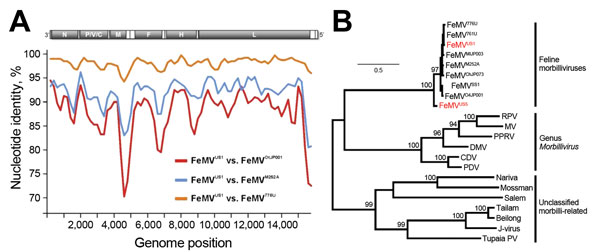Volume 22, Number 4—April 2016
Letter
Chronic Infection of Domestic Cats with Feline Morbillivirus, United States
Figure

Figure. Phylogenetic analysis of feline morbillivirus (FeMV) whole genomes and hemagglutinin (H) genes collected from cats in the United States. A) Genomic sequence identity of FeMVUS1, compared with Asian strains, performed by using SSE V1.2 software (4) with a sliding window of 400 and a step size of 40 nt. B) Maximum-likelihood phylogeny of the translated H gene of FeMVs, the genus Morbillivirus, sensu strictu, and unclassified morbilli-related viruses was determined by using MEGA5 software (5) and applying the Whelan-and-Goldman substitution model and a complete deletion option. Numbers at nodes indicate support of grouping from 1,000 bootstrap replicates. Scale bar indicates substitutions per site.
References
- Woo PC, Lau SK, Wong BH, Fan RY, Wong AY, Zhang AJ, Feline morbillivirus, a previously undescribed paramyxovirus associated with tubulointerstitial nephritis in domestic cats. Proc Natl Acad Sci U S A. 2012;109:5435–40. DOIPubMedGoogle Scholar
- Furuya T, Sassa Y, Omatsu T, Nagai M, Fukushima R, Shibutani M, Existence of feline morbillivirus infection in Japanese cat populations. Arch Virol. 2014;159:371–3. DOIPubMedGoogle Scholar
- Nambulli S, Sharp CR, Acciardo AS, Drexler JF, Duprex WP. Mapping the evolutionary trajectories of morbilliviruses: what, where, and whither. Curr Opin Virol. 2016. In press. DOIPubMedGoogle Scholar
- Simmonds P. SSE: a nucleotide and amino acid sequence analysis platform. BMC Res Notes. 2012;5:50. DOIPubMedGoogle Scholar
- Tamura K, Peterson D, Peterson N, Stecher G, Nei M, Kumar S. MEGA5: molecular evolutionary genetics analysis using maximum likelihood, evolutionary distance, and maximum parsimony methods. Mol Biol Evol. 2011;28:2731–9. DOIPubMedGoogle Scholar
- Drexler JF, Corman VM, Müller MA, Maganga GD, Vallo P, Binger T, Bats host major mammalian paramyxoviruses. Nat Commun. 2012;3:796.
- Parrish CR, Kawaoka Y. The origins of new pandemic viruses: the acquisition of new host ranges by canine parvovirus and influenza A viruses. Annu Rev Microbiol. 2005;59:553–86. DOIPubMedGoogle Scholar
- Ludlow M, Rennick LJ, Nambulli S, de Swart RL, Duprex WP. Using the ferret model to study morbillivirus entry, spread, transmission and cross-species infection. Curr Opin Virol. 2014;4:15–23.
- Rima BK, Duprex WP. Molecular mechanisms of measles virus persistence. Virus Res. 2005;111:132–47. DOIPubMedGoogle Scholar
- Lawler DF, Evans RH, Chase K, Ellersieck M, Li Q, Larson BT, The aging feline kidney: a model mortality antagonist? J Feline Med Surg. 2006;8:363–71. DOIPubMedGoogle Scholar
Page created: March 16, 2016
Page updated: March 16, 2016
Page reviewed: March 16, 2016
The conclusions, findings, and opinions expressed by authors contributing to this journal do not necessarily reflect the official position of the U.S. Department of Health and Human Services, the Public Health Service, the Centers for Disease Control and Prevention, or the authors' affiliated institutions. Use of trade names is for identification only and does not imply endorsement by any of the groups named above.